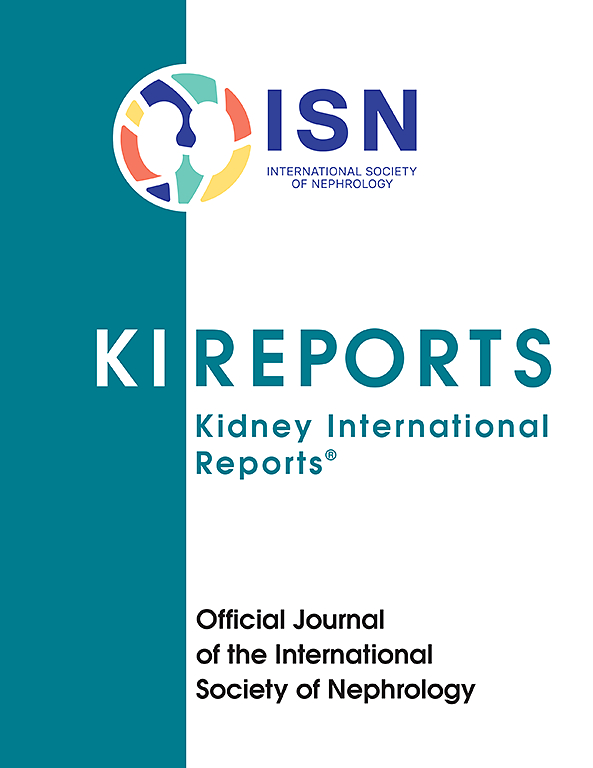Risk of End-Stage Kidney Disease and Topiramate Use
IF 5.7
2区 医学
Q1 UROLOGY & NEPHROLOGY
引用次数: 0
Abstract
Introduction
Topiramate is widely used for migraine prevention but has pleiotropic effects on renal sodium reabsorption and inflammation. Whether these effects could be associated with lower risk of end-stage kidney disease (ESKD) and cardiovascular outcomes is unknown.
Methods
Among 1,745,580 patients with a diagnosis of migraine, the risk of ESKD, cardiovascular outcomes, and death was assessed after propensity matching in patients treated with topiramate versus untreated patients.
Results
Overall, 317,936 patients treated with topiramate were properly matched with 317,936 controls by age (43 years old), sex (women: 86%), clinical and biological parameters, comorbid conditions, and baseline medications. After a median follow-up of 3.5 years, patients receiving topiramate had a significant lower risk of ESKD (hazard ratio [HR]: 0.850; 95% confidence interval [CI]: 0.776–0.930; P < 0.0001). Among the subgroup of patients with available data, patients treated with topiramate had a smaller estimated glomerular filtration rate (eGFR) decline over time than the other patients. Albuminuria remained stable during follow-up in the topiramate group but increased in the other patients. They also had a lower risk of death (HR: 0.827 [0.799–0.856]), cardiac arrest or ventricular tachycardia/fibrillation (HR: 0.944 [0.898–0.992]), but a higher risk of ischemic stroke or thromboembolism (HR: 1.366 [1.318–1.416]) than other patients. Similar results were observed when men and women were analyzed separately. No association was found between topiramate use and risks of myocardial infarction, atrial fibrillation, or heart failure.
Conclusion
In men and women with migraine, topiramate was significantly associated with lower risks of ESKD and death, but higher risks of ischemic stroke or thromboembolism.

终末期肾病的风险与托吡酯的使用
托吡酯被广泛用于偏头痛预防,但对肾脏钠重吸收和炎症有多效性影响。这些作用是否与终末期肾病(ESKD)和心血管结局的低风险相关尚不清楚。方法:在1,745,580例诊断为偏头痛的患者中,对托吡酯治疗与未治疗的患者进行倾向匹配后,评估ESKD、心血管结局和死亡的风险。结果总体而言,317,936例接受托吡酯治疗的患者在年龄(43岁)、性别(女性:86%)、临床和生物学参数、合并症和基线药物方面与317,936例对照组正确匹配。中位随访3.5年后,接受托吡酯治疗的患者发生ESKD的风险显著降低(风险比[HR]: 0.850;95%置信区间[CI]: 0.776-0.930;P & lt;0.0001)。在有可用数据的患者亚组中,接受托吡酯治疗的患者估计肾小球滤过率(eGFR)随时间下降的程度小于其他患者。托吡酯组的蛋白尿在随访期间保持稳定,但其他患者的蛋白尿增加。他们的死亡风险(HR: 0.827[0.799-0.856])、心脏骤停或室性心动过速/颤动(HR: 0.944[0.898-0.992])也低于其他患者,但缺血性卒中或血栓栓塞的风险(HR: 1.366[1.318-1.416])高于其他患者。当对男性和女性分别进行分析时,也观察到类似的结果。未发现托吡酯的使用与心肌梗死、心房颤动或心力衰竭的风险有关联。结论:在男性和女性偏头痛患者中,托吡酯与ESKD和死亡风险降低显著相关,但与缺血性卒中或血栓栓塞风险升高相关。
本文章由计算机程序翻译,如有差异,请以英文原文为准。
求助全文
约1分钟内获得全文
求助全文
来源期刊

Kidney International Reports
Medicine-Nephrology
CiteScore
7.70
自引率
3.30%
发文量
1578
审稿时长
8 weeks
期刊介绍:
Kidney International Reports, an official journal of the International Society of Nephrology, is a peer-reviewed, open access journal devoted to the publication of leading research and developments related to kidney disease. With the primary aim of contributing to improved care of patients with kidney disease, the journal will publish original clinical and select translational articles and educational content related to the pathogenesis, evaluation and management of acute and chronic kidney disease, end stage renal disease (including transplantation), acid-base, fluid and electrolyte disturbances and hypertension. Of particular interest are submissions related to clinical trials, epidemiology, systematic reviews (including meta-analyses) and outcomes research. The journal will also provide a platform for wider dissemination of national and regional guidelines as well as consensus meeting reports.
 求助内容:
求助内容: 应助结果提醒方式:
应助结果提醒方式:


